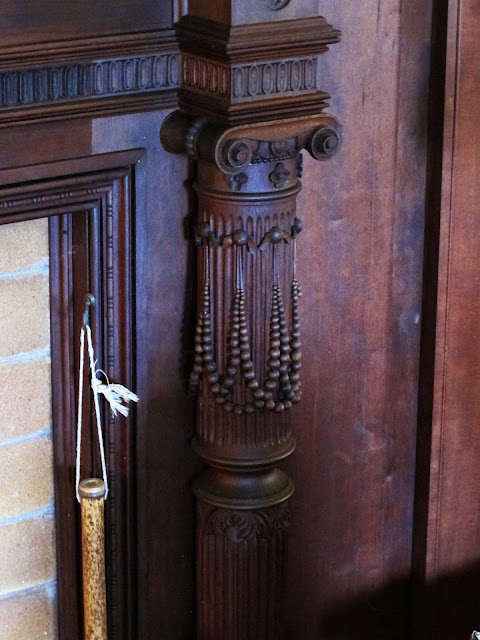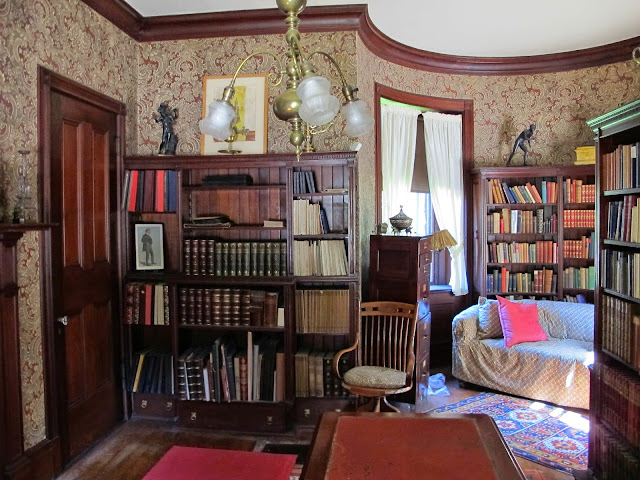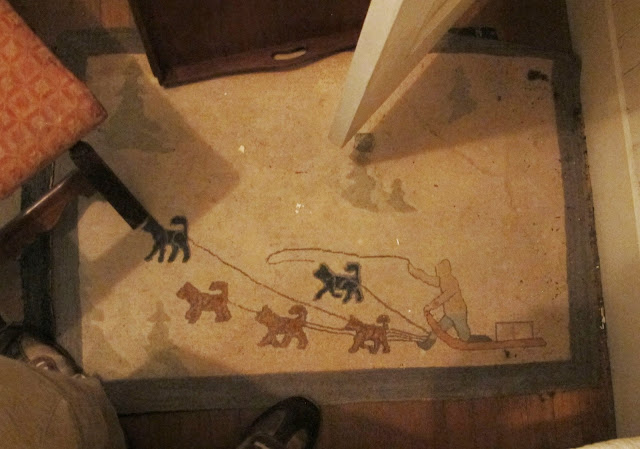It lurks Loire-ishly behind tall stone walls on a chic road in Stockbridge, Mass. Exactly what kind of a house is this? Answer: It's a "Modernized Colonial." (A what?)
Let's proceed past my standard locator shot (Big-Old-Housemobile at gate), progress up the drive, and I will explain this preposterous sounding assertion.
Naumkeag, the summer house of lawyer-diplomat Joseph Hodges Choate (1832-1917) was designed in 1885 by a 32-year-old architect named Stanford White, principal in a not yet famous firm (it was only 6 years old) called McKim Mead and White. In the patriotic riptide following America's centenial, young architects like White embarked on an earnest search for a uniquely "American" stye of architecture. The results, seen at least from our perspective, were way out there.
"In studying (American) colonial work," architect Robert Swain Peabody (1845-1917) announced from the lectern of the AIA's 1877 convention in Boston, "we find all the delicacy, grace and picturesqueness that any model can suggest to us; and, combined with it, a familiar aspect, and a fitness to harmonize with heirlooms and old possessions," "heirlooms" and "old possessions" being buzzwords in culturally defensive America.
OK, but how exactly do these sentiments explain Naumkeag? "What we shall care for," Peabody continued, "is not... historical accuracy, but the artist's clever art in harmonizing whatever his fancy does lead him to." It led Stanford White down a highly original path as a slow circuit around Naumkeag soon reveals.
Historical accuracy has clearly been no impediment to White's vigorous design. Naumkeag is a sort of architectural mullet; business up front, party in the back. Stylistically it is all over the place, which actually endears it to modern eyes. To our parents, however, or at least to my parents, houses like Naumkeag were "prima facie" evidence of an aesthetic Reign of Terror.
See anything "colonial" on Naumkeag's rear facade? There's actually a lot - gables, tall chimneys, 12 over 12 sash, a bay window, shutters, the faintly Palladian treatment of triple windows on the 3rd floor, etc.. White has taken Peabody at his word and thrown all manner of things familiar to the American eye - plus a few that aren't so familiar - into an unfettered bouillabaisse. And it works.
Having said all that, it's hard to ascribe anything American to the front porch.
Here is Joseph Hodges Choate, the master of Naumkeag, a man of "wit, luminous intelligence and social charm," who "practiced law as a liberal art and not as a mere business," according to his May 16, 1917 obituary in the New York Times. I love old Times obits, which brim with quotable tidbits like: "He is regarded as representative... of the very best there is in the Anglo-Saxon race," and "He is more sought after to represent important interests (than) any other lawyer in America." Those interests included the Standard Oil Trust, the Tobacco Trust and numerous society types. OK, not exactly a voice of the people. In 1894, Choate represented a certain Charles Pollack in a suit against the Farmers' Loan & Trust Company. Via arguments unintelligible to me, this case led to an 1895 U.S. Supreme Court decision declaring the income tax unconstitutional. The 16th Amendent corrected that, but not until 1913.
Mr. Choate was also, between 1899 and 1905, America's ambassador to the Court of St. James, a plum if ever there was, and one in which he became famous for grace, popularity, effectiveness and wit. Concerning the latter, here is Mrs. Choate (1839-1929), nee Caroline Sterling, the object of what were probably her husband's most famous "bon mots." Asked what he would be if he had another life to lead, Choate replied, "Mrs. Choate's second husband." Not as well remembered, but more amusing at least to me, was his opinion on whether or not the Village of Stockbridge should construct a fence around a local family graveyard called, rather deliciously, the Sedgewick Pie. Since no one outside of it wanted to get in, he observed, and no one inside of it was going to get out, why spend the money?
Collections curator Mark Wilson is today's patient guide.
White's main hall at Naumkeag is a modest version of the "living hall," a picturesquely useless homage to the Middle Ages, when nobles, together with families and retinues, all lived in one big room. In fashionable American houses of the 1880s, living halls could be quite vast. The woodwork, proportions and detailing in Naumkeag's main hall are certainly charming, but a "living hall" it ain't.
The images below are of the drawing room, or parlor on the plan. There is no reception room at Naumkeag; the parlor did for visitors great and small. This speaks to the comparative informality of little Stockbridge, as opposed to the stately formality of neighboring Lenox, the former "Newport of the hills." Asked why he chose to build in one instead of the other, Choate explained, "In Stockbridge, you are esteemed; in Lenox, you are estimated."
The Choates had uneven luck with children. Son Ruluff, whose Saint-Gaudens bust stands beside the drawing room fireplace, died in New York at the age of 19; younger brother George spent his adult life in a private sanitarium; sickly sister Josephine died an invalid at the age of 27. Only Joseph Jr. married and had children. His sister Mabel, the last resident at Naumkeag, died in 1958 at age 88, after a long, active, philanthropic and unmarried life.
Ruluff's bust is on one side of the fireplace; a door to the library is on the other.
This is the sort of room you get in a Stanford White house - domestically scaled but completely elegant, quite functional and wholly inviting. Speaking of inviting, prior to Choate's purchase of Naumkeag's 46 acres, he picnicked with his family under a specimen oak located about 100 feet from the corner of this room. The land belonged to David Dudley Field, a famous reformer and, interestingly, defender of unpopular defendants. One of those was William (Boss) Tweed, the Tammany Hall uber-thief who wound up behind bars at the hands of opposing counsel, Joseph Choate. Which fact seems in no way to have affected a real estate transaction between two gentlemen.
During the summer of 1897, in the dining room across the hall, the Choates hosted President McKinley for lunch.
A baize covered swing door leads to a perfectly preserved serving pantry connected by dumbwaiter to the basement kitchen. An appealing old house gloom suffuses it and the service areas beyond.
The basement is largely intact as well, although the servant hall has been replaced by public rest rooms and the kitchen's now a gift shop.
In the image below we're back on the main floor following Mark to the school room.
Beyond the school room is Mr. Choate's study. I wonder if I'll ever have a painting of myself over my study fireplace. (Not holding my breath).
There are 6 bedrooms on the 2nd floor, 7 if you count a dressing room attached to a guest room in the south tower.
For 12 summers between her husband's death in 1917 and her own in 1929, Mrs. Choate slept in the bedroom at the top of the stairs. Her daughter Mabel, after inheriting Naumkeag in 1929, moved into her mother's room and used it until she died in 1958.
How wonderful to have a John Singer Sargent sketch of yourself.
Even when departing families leave all the furniture behind, as was the case with Naumkeag, and even if you take away all the tourist ropes and runners, there's still a slightly sad unlived-in feel to the place.
When the Choates' returned from bathroom-less Britain in 1906, they had 3 new ones installed in their Stockbridge summer house.
This is the sort of small treasure I get to see, and normal visitors don't.
Fake wall tiles in the master bath look to me like a 1930s update. The linen closet remains completely stocked.
At the north end of the second floor landing are stairs to 3. Servants occupied one end of the 3rd floor, and succeeding generations of children and grandchildren occupied the other.
Time to head down, and out.
Mabel Choate didn't changed her parents' house, but the grounds around it were another story. For 30 years, starting in 1926, she worked with landscape architect Fletcher Steele (1885-1971) to transform a challenging hillside site into a series of inventive outdoor rooms. Naumkeag's famous gardens are not just an architectural and aesthetic tour de force, they are magnificently maintained. The glimpses below are only that...glimpses.
Mr. Choate's estate, which totaled a little under $5 million, included a house at 8 East 63rd St. appraised at $105,000, and a cellar with 483 bottles of wine (including 100-year-old cognacs), valued at $5 a bottle. The week he died was a busy one, spent entertaining French and British war envoys. "I am feeling very ill," he told his wife on the evening of May 14th, 1917, adding, "I think this is the end." He died 90 minutes later at the age of 85. Naumkeag is owned today by the Trustees of Reservations, a Massachusetts preservation non-profit that labors tirelessly on the side of the angels. The link is www.thetrustees.org.


































































































